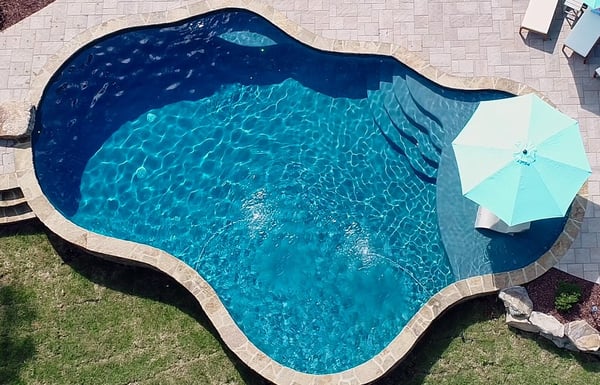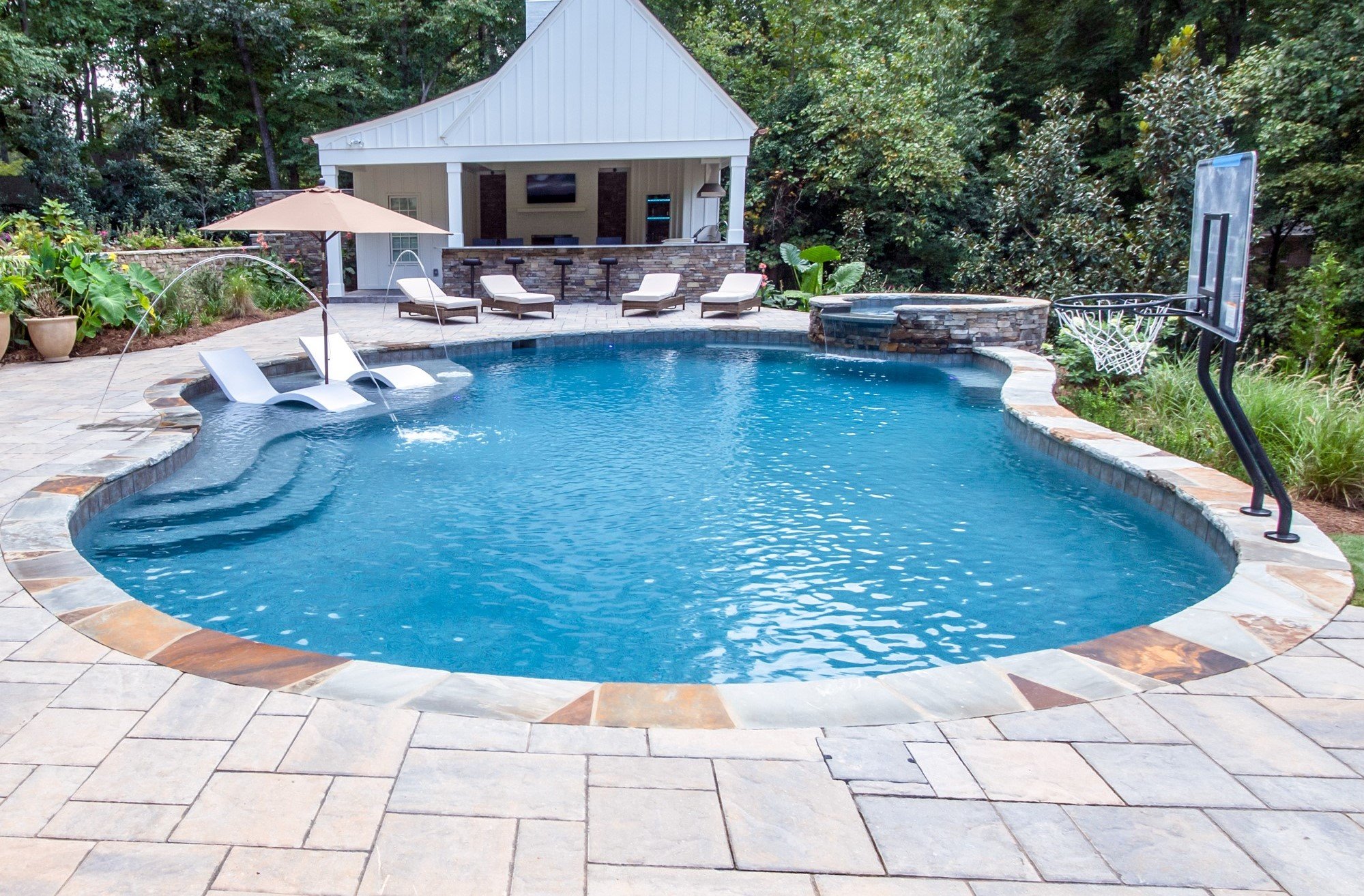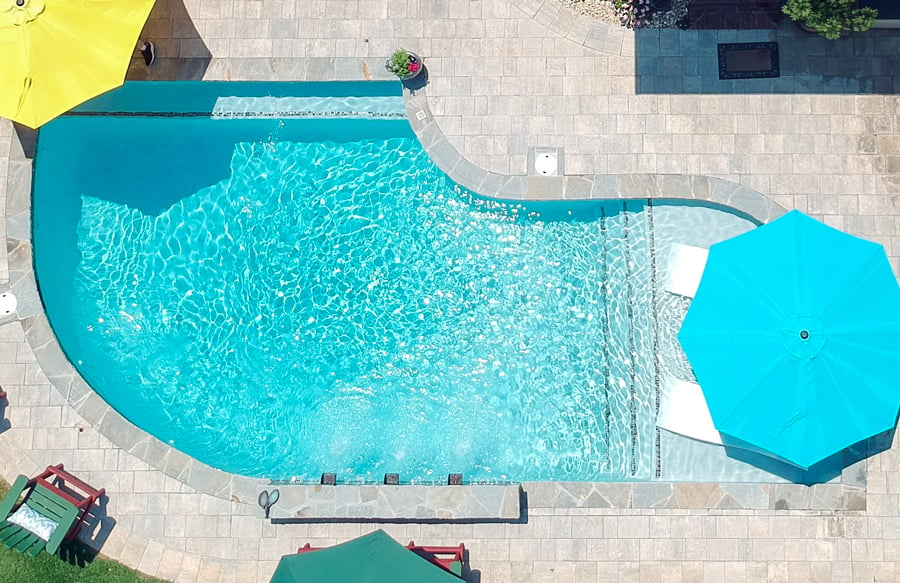—Effective methods for protecting pools, decks, and backyards from water damage

Water drainage—routing unwanted rain or runoff water away from certain structures and areas to targeted collection or escape points—serves as a critical component of maintaining your swimming pool and backyard.
A proper drainage system helps ensure that the water in your inground pool remains clean and protects your surrounding yard, deck, patio, landscaping, and home from possible water damage, erosion, and debris.
When building a new swimming pool and deck, you and your contractor have several proven options for keeping runoff water from harming features on your outdoor property.
Why drainage matters
First, it’s important to understand the essential role that drainage plays in the design and operation of an inground pool and the deck and yard around it.
The combination and kinds of elements and features in each unique backyard create different needs for drainage.
For example, a property with a lush garden with lots of watering will require a more extensive drainage system, then say, one that’s hardscaped with just a few succulent plants in a desert region.
An inground pool and the surrounding deck also require varying amounts of drainage, which we’ll discuss below. Other elements in your yard can also play a factor.
Understanding your backyard’s needs will help determine what option makes the most sense for meeting those drainage requirements. Drainage serves two primary purposes:
- Keeping outside water from rain, snow, roof gutters, sprinkler and garden irrigation systems, and debris out of the pool.
- Preventing pool water splash-out from puddling up on the deck and damaging the material over time or from landing on adjacent landscaping and harming plant life.
How poor drainage can upset your swimming pool and patio area

Rainwater or runoff water from a garden, roof gutters, melting snow, or other sources is bad news for your inground pool.
This “foreign” water is not filtered or sanitized the way pool water is. As a result, it often contains an array of debris, bacteria, and soil phosphates.
When these unwanted contaminants find their way into pool water, they can wreak havoc on your pool’s filtration system and throw the water balance out of whack.
When this invasion is underway in your pool, the filtration system must work in overdrive to maintain balance. Chemical levels, alkalinity, and pH go haywire—making your pool highly vulnerable for algae growth, bacteria build-up, and other hazards.
Sometimes, these changes can spiral out of control quickly. If so, your only solution will be a complete drain and deep clean of the pool’s surface—a costly, time-consuming hassle.
On the other hand, the normal water inside the pool can become something of a hazard too. It may make its way out of your aquatic resort during regular use.
Playing around, performing cannonballs, accidentally overfilling the water level, or your pooch jumping in to cool off—any of these activities can produce splash-out.
Large or repeat amounts of splash-out can form small puddles on the adjacent deck. They can also reach nearby landscaping.
Over time, this chemically treated pool water can eat away and bleach deck material and disrupt soil balance for plant life.
Additionally, if enough splash-out occurs to produce puddles on your pool deck, this standing water becomes a slip hazard.
Repairing damage to decks and concrete hardscape features can also be costly and time-consuming. For example, if your concrete deck becomes damaged in one small area, it’s usually not a straightforward fix.
If your concrete has any type of sealant on it, you have to figure out how to remove the concrete sealant, repair the cracks, remove the stain, reseal, and complete this process repeatedly to avoid having to replace the entire deck.
If your concrete is not sealed, and it is instead a brushed or broom finished, you might get away with resurfacing only the damaged portions—but only if the affected areas are minimal. Either way, damage to your concrete patios isn’t something you want to have to deal with over and over again.
One way to prevent these kinds of problems in the first place is to use the design of your pool deck as the first line of defense against water build-up.
Make your deck design strategic
That’s right: One of the primary solutions lies in the design of the deck itself.
In this approach, you can have your contractor design and build a deck with a slight slope that allows water to flow away from the pool.
Alternatively, the deck design can include certain drain and plumbing configurations that combat water build-up. A professional deck installer will be able to provide options based on your yard, kind of deck, and its layout and configuration.
In addition to, or instead of, a sloping deck, three kinds of other drainage options for your backyard pool are available. Let’s take a look at each solution and how they help control runoff water around your pool and yard.
Solution #1: Deck-O-Drains
Popular for decades among pool contractors, Deck-O-Drains are sleek, plastic drains that fit into virtually any concrete-based deck design. These units provide a variety of benefits that make this kind of drain a top choice for pools, driveways, patios, and other heavy-traffic outdoor areas.
One major advantage is appearance. Deck-O-Drains come in several colors, so you have options for selecting one that will visually blend with the color of your deck. Once installed, the color—coupled with the streamlined design—makes Deck-O-Drains mostly undetectable.
Another reason why this drain is an ideal choice is its ease of installation. Because they don’t require a contractor to dig trenches or a heavy grate, less labor is involved.
In addition, the drains come in several configurations that can channel excess water in various directions as needed. For a contractor, that means flexibility in determining where each drain goes within the deck configuration, and installing them is a straightforward process.
Deck-O-Drains are also low maintenance. Cleaning one is much easier than a traditional grate drain. In addition, unlike many grate drains, a Deck-O-Drain’s plastic design makes them resistant to corrosion so they can provide years of performance.
Most often, a deck contractor will integrate these kinds of drains into the patio design. During construction, crews will pour concrete around each drain to hold it in place. In the case of a paver stone deck, they will set pavers in a manner to hold each drain in place.
Solution #2: Permeable Paving Installations
Permeable paving is what happens when science meets outdoor design.
Permeable pavers are porous molded structures that replace traditional concrete pavers. However, unlike their conventional concrete cousins, they also serve the function of controlling excess water.
The design structure of permeable pavers actually catch and absorb incoming water. Each one stores the water inside its configuration.
If you open up the top of a permeable paver, you will see a layer of open cells. These cells collect the water and allow it to drain into a layer of gravel or other composites that lie at the bottom of the paver.
Beneath the paver, the soil exists as it normally does. The paver’s trapping and storage action allow the water time to drain into the soil below it.
It’s all technical engineering and science at its finest. Essentially, permeable pavers work by mimicking the way the earth naturally absorbs water—versus the way that wood, concrete, or other materials allow water to collect on their surface.
As a result, the pavers deliver a drainage solution. If excess water from rain or other sources is present, the pavers can store it in their cells until all of it all absorbs into the soil below.
The pavers’ performance delivers superb value for your backyard. Here’s why: Generally, homeowners have to wait for excess water to evaporate on concrete and wood.
This dry-out process can take a lot of time. But with permeable pavers, the system gives the excess water a place to go instead of remaining on the deck or patio surface—so there’s no long waiting for water to evaporate.
Overall, a permeable paving system provides an install-it and forget-it option. Once your installation is in place, there’s no extra cleaning or maintenance afterward.
Now, if you live in a particularly rainy region or have a backyard with certain conditions producing excess water in your property, take note: You might need an additional drainage solution for the yard. (As previously discussed, various backyard designs, features, and elements impact drainage needs and configurations.)
The good news is that comprehensive permeable pavement solutions for total yard drainage are available. So, you can effectively cover your entire outdoor space with this system and achieve a drainage solution for not only your pool but for all of your outdoor space.
Several kinds of permeable pavement options are available. Among them: permeable concrete, grid pavers, and interlocking pavers. Choosing one will come down to your aesthetic and functional preferences.
A tip about permeable pavers relating to maintenance: You cannot seal these pavers like you can other kinds of pavers; otherwise, they won’t function properly.
Solution #3: Catch Basin Installations
A third drainage solution represents another solid choice for efficiently preventing unwanted puddles of standing water and associated hazards.
Catch basin drainage systems, such as a French drain, provide a tried-and-true drainage option for backyards and pools.
This system’s primary function is carrying excess water away from your property and directing it toward one of several kinds of catch basins or other collection or escape points.
Compared to Deck-O-Drains and permeable paving, these systems involve a more complex installation and a few moving parts.
This installation begins with digging trenches in the ground. They are dug to slope in desired directions. The slope means gravity will help move the water in a specific direction.
Next, multiple pipes go into the trenches. Often, a layer of gravel or crushed stone will be laid beneath the pipes in the trench.
These pipes are distinct; they contain pre-made perforations. The series of holes in each pipe allows water to slowly escape from it.
The pipes collect water that has seeped in from above, and they route it into one or more catch basins or other strategic collection points.
Catch basins vary in size, shape, type, placement, and configuration. In some cases, they include some kind of grate over an inlet. Typically, that inlet, a plastic or concrete basin, captures and holds the water.
From that point, the water is redirected to a designated collection area. In some cases, this may be the front of the house where the water can flow into the street’s gutter system.
In some backyards, it is not possible—due to distance, elevations, or other physical obstacles—to steer the water toward the front yard.
That creates a need for an alternative method. The answer is to manage the excess water somewhere in backyard or in another section of the property.
One tactic is taking advantage of open spaces adjacent to the property, such as a field, hillside, marsh, canyon, or nearby shoreline.
One option is to build what’s known as a dry catch basin or dry well. When building a pool—depending on its configuration in your yard and the size and design of the surrounding deck, the contractor may build dry catch basins beneath the deck, where large amounts of water are likely to build up.
Alternatively, catch basins can be installed underground where rain or runoff water tends to flow and and eventually fully absorb.
Another method is a backyard drainage ditch or unused area of neighboring land where water can evaporate properly—without harming your patio or yard.
Choosing the right drainage system

We have discussed how drainage impacts the overall condition of your pool, yard, and deck, and we presented three drainage options you have for your inground pool.
The best bet is to speak to your contractor directly about your aesthetic and functional goals. A seasoned professional will be able to help you choose a drainage system that fits the bill.
The critical point here is that you ensure that you have a drainage system in place. It will be vital for preserving the long-term health of your inground pool and protecting your outdoor space.
Matt Lee is the owner of the Innovative Building Materials blog and a content writer for the building materials industry. He focuses on helping fellow homeowners, contractors, and architects discover materials and construction methods that save money, improve energy efficiency, and increase property value.




.jpg?width=1490&name=rock-waterfall-slide-pool%20(1).jpg)
